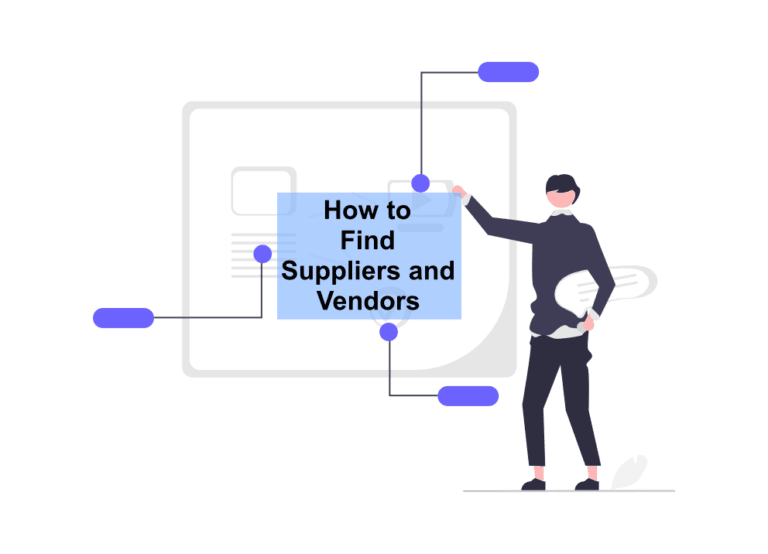
5 Steps to Finding and Managing Suppliers and Vendors Like a Pro: Secrets for Successfully Building Your Business’s Supply Chain!
Working with suppliers and vendors is an essential part of business – from stocking products to securing services. But for companies new to the process, finding and managing suppliers and vendors can be a challenge. To help you smoothly navigate this intricate process, we’ve outlined key steps to identify and manage successful relationships with suppliers and vendors. By developing an effective approach at each stage of this process, you can ensure all levels of your organization will have seamless access to the high-quality products and services they need for success.
Why it is important to find and manage vendors and suppliers for your business
Its important to find and manage supplier for your business for several reasons, with one of the most important having consistent access to products and services for your customers.
- Access to products and services: For any business, having access to the products and services needed to maintain operations is absolutely essential. That’s why it’s so important for businesses to establish strong relationships with their suppliers and vendors – these partnerships can ensure that whatever your business needs to stay running will always be available. These relationships may be particularly important for businesses that rely heavily on specific products or services; research potential sources of supply and begin forming connections so you’ll be prepared for when your business needs them. By doing this now, you’ll be able to focus on other aspects of your business instead of worrying about where you’ll find vital supplies in the future.
- Cost Savings: Reducing costs for businesses is always a priority, and selecting the right suppliers could be one of the most effective ways to do that. By identifying suppliers who can offer quality services at competitive prices and take better care of their relationship with their clients, it is possible to negotiate better terms and lower prices. Effectively managing these relationships is key, as well as making sure that both parties understand the expectations and are held accountable. When done right, the cost savings gained by carefully selecting and managing suppliers and vendors can be tremendous.
- Quality Control: Quality control should always be a priority for any business. Working with reliable and well-established vendors and suppliers helps to guarantee that the goods or services you receive will meet your standards and expectations. Doing research beforehand on different providers can help to determine which ones have a good track record in providing quality products and services at competitive prices. Additionally, having multiple checks on goods every step of the production process as they are delivered is another way of ensuring a consistently high standard of product or service. By taking these precautions, businesses can have peace of mind that they are investing in goods and services they can trust.
- Reliability: Creating and maintaining reliable relationships with suppliers and vendors is crucial for business success. It can be especially important in industries that require regular access to specific materials or services in order to operate effectively. When businesses have strong and dependable supplier relationships, they are more likely to enjoy a steady flow of resources that they can reliably count on when they need them. This can also lead to better pricing as businesses can negotiate better prices knowing their suppliers rely on them for consistent orders over time. Investing time and effort into forming trustworthy partnerships with suppliers can reap tremendous rewards for businesses looking to grow and expand their operations.
- Customer Satisfaction: Businesses have a big responsibility to keep their customers happy, and one of the best ways to do that is by working with suppliers and vendors who maintain high levels of quality. Quality products and services are paramount in ensuring your customers are being provided with the very best, which will boost customer satisfaction. Investing in good suppliers will not only maintain consistent quality over time, but it will also improve customer loyalty. Keeping customers loyal can come with long-term cost reductions and a positive brand image which contribute to business success.
Overall, finding and managing suppliers and vendors is not always easy but is always worth it. It can help ensure access to the products that your business needs to be successful.
5 Steps to finding and managing suppliers and vendors: a vendor management process
When running a business, ensuring you work with the right suppliers and vendors is essential for keeping your operation on track. Building relationships with reliable partners that provide quality products and services at competitive prices can give you access to the resources you need to run your business, save money in the long run, and ensure that your customers are satisfied. That’s why knowing how to find and manage these relationships is one of the keys to success for any entrepreneur or manager.
Step 1: Identify your supplier and vendor needs.
Before you start looking for vendors it is import to know exactly what you need. Think about what requirement you may have and list them in order of importance. Different businesses in different stages of their business journey need different things. It may be more important to find a business that has good terms instead of quick shipping.
Here are some steps to identifying your supplier or vendor needs.
1. What products or services: You want to think about the specific products or services that you need to operate your business. Be as specific as you can – for example; if you are a retail business you need will need products to sell on a consistent basis.
2. Quantity: How much do you need of each item or service, can the supplier or vendor actually deliver it in a timely manner or is it outside of their scope work.
3. Delivery requirements: Are you going to require the products be delivered directly to the customer or to a warehouse. How much will need to be delivered each time.
4. Other Requirements: Each business is going to have specific requirements that is specific to that business. It can be anything from payment terms to discounts for bulk orders. You need to focus on what you the overall goals of your business are and how a vendor or supplier can help make that happen for your business.
Step 2: Research potential supplier and vendors
Once you know what you need it is time to start research potential suppliers and vendors.
Tips on finding and researching suppliers and vendors-
Tip 1. Online directories: Online directories are a great resource for discovering new potential suppliers and vendors, especially in industries where these professional relationships can be difficult to build. These directories offer key information and evaluations of these businesses, so you have an informed approach before entering negotiations.
Tip 2. Trade shows: Attending a trade show is a great way to efficiently build your business relationships and make meaningful connections. Here, you will find many potential suppliers and vendors, giving you the chance to interact with them face-to-face, learn about their products or service offerings, and decide if they are the right fit for your needs. Trade shows provide an great opportunity to truly gain an understanding of what a supplier or vendor is offering and identify whether or not it will help your business grow. By taking advantage of this one-on-one opportunity at trade shows, as opposed to spending time researching each supplier or vendor’s offerings online, you can quickly determine which are worth considering further and which should be left behind.
Tip 3. Industry Events: Attending industry events is a great way for businesses to network and grow. Not only can you make meaningful connections, but there are often materials such as brochures available that inform attendees of the latest products and services on the market. For those looking to find potential vendors or suppliers, it is an ideal environment to ask the right questions and establish valuable relationships. Industry events can be a major advantage for growing any business, so it’s important to take advantage of all the networking opportunities available.
Tip 4. Personal Connections: Not every business can rely solely on the internet to find the supplies and vendors they need. Reaching out to your personal network is an excellent tool for discovering new contacts that could be perfect for you. Ask around — fellow business owners or industry professionals often have firsthand experience dealing with different suppliers and vendors, so their insights and recommendations can be invaluable. Building a good relationship with others in the same industry ensures that if you ever need help, there’ll always be someone who can point your way in the right direction. So don’t hesitate to make use of your contacts– one connection could lead you closer to finding the supplier that has exactly what you’re looking for.
Step 3: Evaluate potential suppliers or vendors
It’s essential to take the time to evaluate potential suppliers and vendors thoroughly to make sure they are a suitable fit for your business. Pricing, product quality, delivery times, and customer service should all be considered in your assessment. Speak with each option directly and don’t forget to check reviews online. Take the time to research beyond their initial sales pitch—request samples, ask questions, read contracts in detail—then make an informed decision based on a combination of data and gut instinct. Making the right vendor choice can help create long-term success for your business.
Some thing to consider when evaluating potential suppliers or vendors
- Price: When evaluating different suppliers and vendors, it is critical to consider the price of their products and services. Often times, a supplier offering a slightly lower rate in comparison to other options can provide more significant savings over the course of a purchasing agreement. It is also advisable to research if the supplier offers any bulk discounts or long-term contracts. These types of deals could potentially reduce your costs substantially while providing reliable services and products over time. Doing your homework upfront can help ensure you are getting great value for your money.
- Quality: Making sure that the products and services you purchase meet your high standards is critical to the success of any venture. Be sure to look at the quality of offerings from each supplier or vendor carefully – are they backed by a good reputation in their respective industry? If they have a poor service record or have consistently had complaints regarding their product, then it’s best to move on and find another option. Before making any decisions, take the time necessary to compare several suppliers, evaluating them based on both quality and cost. Doing so can save significant amounts of money and ensure a successful long-term relationship with vendors.
- Delivery times: Make sure the delivery times are satisfactory for your needs. Does the supplier keep a stock in a local warehouse or do they need to ship it in from overseas. This will have an impact on how soon you can get your supplies.
- Customer service: Take a look at the customer service that they can provide. Are they responsive with your questions, do they have a good reputation online, what is their customer service department like? These will all have an impact on your relationship with your vendor.
By considering these factors you will have a better chance of finding a vendor that will meet your needs and save you some headaches down the road.
Step 4: Negotiate the terms
Once you have identified the best supplier for your business, it is time to negotiate the terms of your agreement. This is one of the most important steps because it can save you a lot of money in the long run.
Here are some things to take into consideration when negotiating with your supplier or vendor.
Price: One of the most important is going to be the price, you need to investigate what pricing discounts they offer and how can you obtain them. Is it based on order volume or order frequency, if you pay quickly can they offer a specific percentage off? Each supplier will have specific terms that they can offer and it is important to ask for them and hold your ground in a negotiation especially if you are going to be good long term partner for this supplier.
Delivery Schedules: You want to discuss the delivery schedules that will work the best for your business while giving you the greatest control over the quantity and timeliness of the shipments.
Payment Terms: Negotiate on the payment terms that will work best for your business goal. Would you rather pay on time each month for discount or have them carry the terms for at least 90 days or more. This will all depend on your business model and cash flow expectancy .
By negotiating the terms you can put yourself in the best position to succeed. Make sure that you do not enter into a bad deal just for some short term gain.
Step 5: Manage the relationship.
Once you have started a relationship with a supplier or vendor it is important to manage the relationship effectively so that it is mutually beneficial.
Here are some things you can do to manage the relationship:
- Regularly communicate with the supplier or vendor
- Resolve any issues that arise
- Keep track of deliveries and payments.
By managing this effectively you can head off any disagreements and shipping delays that may arise.
How do you manage your relationship with vendors and suppliers?
The key to managing your relationship with vendors and suppliers is based on communication, you need to have an open line of communication with your vendors where you feel comfortable reaching out at anytime.
Trust is another big factor in a vendor relationship, you want to be able to trust your supplier and he should be able to trust you in return.
conclusion:
In conclusion, building and managing relationships with suppliers and vendors is an essential part of running a successful business. By following a few key steps, you can find and manage these relationships effectively, ensuring that you have access to the products and services you need to operate, at a price you can afford, with the level of quality and customer service you expect.
The first step is to identify your needs, including the specific products or services you need, the quantity you need, and any delivery or other requirements you have. Next, research potential suppliers or vendors, using online directories, trade shows, industry events, or personal connections to find potential options. Once you have a list of potential suppliers or vendors, evaluate them to ensure they are a good fit for your business, considering factors such as price, quality, delivery times, and customer service.
Once you have identified the best supplier or vendor for your needs, negotiate the terms of your relationship, discussing things like price, delivery schedules, and payment terms. Finally, manage the relationship effectively by maintaining regular communication, resolving any issues that arise, and keeping track of deliveries and payments.
By following these steps, you can build and manage relationships with suppliers and vendors effectively, ensuring that your business has the products and services it needs to operate successfully.










